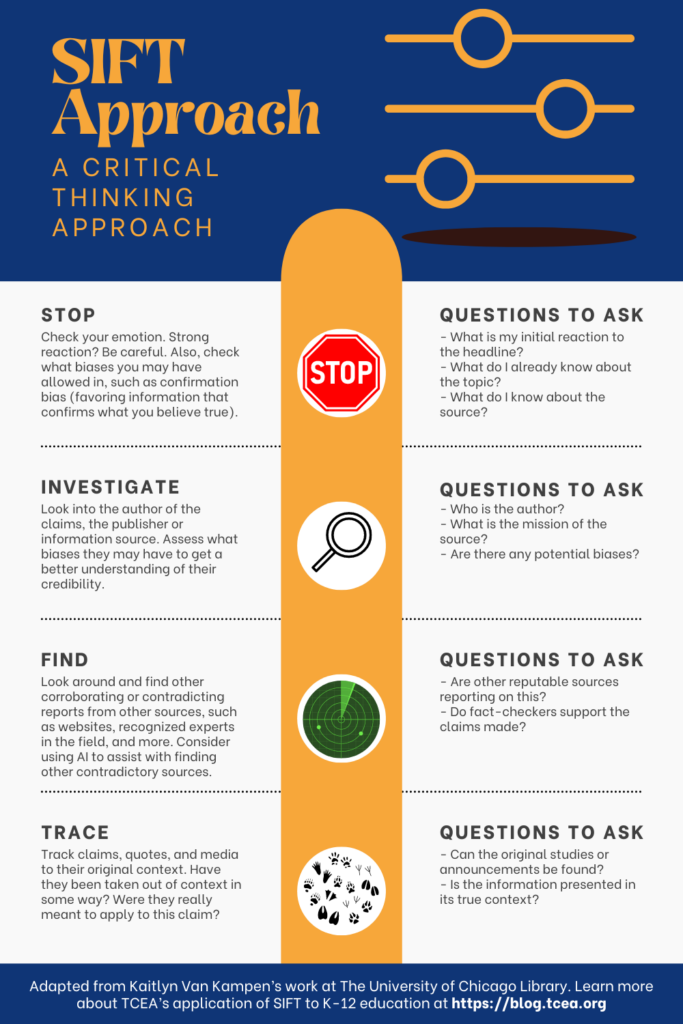The internet is full of information, but how can we tell what’s true and what’s not? What strategies can help us spot credible content versus ads, opinions, and misinformation? How can we practice these skills online to make better decisions?
Explore and Reflect:
Begin by watching the COR* episode on lateral reading to consider different strategies for selecting relevant and fact-based search results.
* Civic Online Reasoning lessons, assessments and videos (3:47:00)
SIFT method

What is information literacy?
An ability to evaluate the information from various digital sources, to judge its accuracy and to determine whether the information comes from a reliable and trusted source is critical for Digital Literacy. This skill is very important in our digital world, where anyone can publish any content online, making information so widespread and readily available.
Consider adopting the following information literacy practices, employing the SIFT method for evaluating digital information:
- Stop: Before diving into the content, take a moment to pause and consider your approach. Resist the urge to immediately accept or reject the information. Ask yourself: What website am I on? What do I know about this site or its author? What is the purpose of this information – to inform, persuade, sell, or something else? This initial pause is crucial for preventing impulsive reactions and setting the stage for more critical evaluation.
- Investigate the Source: Go beyond the surface level of the information. Don’t just look at the specific article or post; investigate the source itself. Is it a well-known and respected organization? Does it have a clear history and mission? Look for an “About Us” page, check the author’s credentials, and see if the site has contact information. Be wary of sites that lack transparency or seem designed to promote a specific agenda without disclosing their bias. If the source seems suspicious or unreliable, the information it presents should be treated with extreme caution.
- Find Trusted Coverage: Look for what other trusted sources say about the information and the original source. Does reputable news media cover the same story? Do fact-checking websites address the claims being made? If multiple trusted sources corroborate the information, it’s more likely to be accurate. Conversely, if no reputable sources mention it, or if fact-checkers debunk it, that’s a strong indication the information is unreliable. This step helps to contextualize the information and identify potential biases.
- Trace Claims to the Original Source: Many pieces of information are shared and re-shared online, often without clear attribution. It’s important to trace claims back to their original source. This can be challenging, but it’s essential for verifying accuracy and understanding the context. Look for links, citations, or references that lead back to the primary source of the information. If the original source is unclear or unavailable, the claim should be viewed with skepticism. By tracing claims, you can avoid being misled by misinformation or distorted narratives.
Practice
Check your knowledge: complete the 4-questions quiz
Information Literacy Quiz
Evaluate a digital source and share your observations.
-
Select a digital source: Choose any article, website, video, or other online content relevant to your field of study or interest.
-
Evaluate using the SIFT method:
- Stop: Pause and consider the source before accepting the information.
- Investigate the Source: Quickly check the author, institution, or website to understand their credibility.
- Find Coverage and Trace: Look for other sources that cover the same topic to see if the information is corroborated.
- Trace Claims: Follow up on claims, quotes, and media to their original context to ensure they are accurately represented.
- Compare Multiple Sources: Open multiple tabs and compare the information across different sources to identify any discrepancies or commonalities.
-
Share: Write a brief evaluation of your source and submit it with the URL of your source using the form below. Add your message as a comment on this page.
Resources
Civic Online Reasoning lessons, assessments and videos. (Create a free account to access)
Basics of Evaluating Online Sources (enroll in a 1-Module Course)
Civic Online Reasoning (enroll in a 3-Module Course)
- Module 1: Search Like a Fact Checker with Lateral Reading
- Module 2: Verifying Claims on Social Media and Click Restraint
- Module 3: Evaluating Different Types of Online Sources
Here are some websites that specialize in uncovering recent fakes and misinformation, these resources can help you stay informed and verify the credibility of the information you encounter:
- FactCheck.org: is dedicated to fact-checking and debunking false claims across various topics, including politics, health, and viral social media posts.
- Snopes.com: is a well-known fact-checking website that investigates rumors, myths, and misinformation circulating online.
- PolitiFact: focuses on fact-checking statements made by politicians and public figures, providing a “Truth-O-Meter” rating to indicate the accuracy of the claims.
- News Guard Tech works with technology platforms, news aggregators, internet service providers, advertising companies, major brands, educational institutions, governments, and researchers to help them spot misinformation and give them more context for the news.
These resources can help you identify and understand the nature of false and fake publications.
- Fake papers are contaminating the world’s scientific literature, fueling a corrupt industry and slowing legitimate lifesaving medical research
- Notice how much effort it takes to uncover misinformation 50 Examples of Fake News in 2024 – Just Facts Daily
Leave a Reply